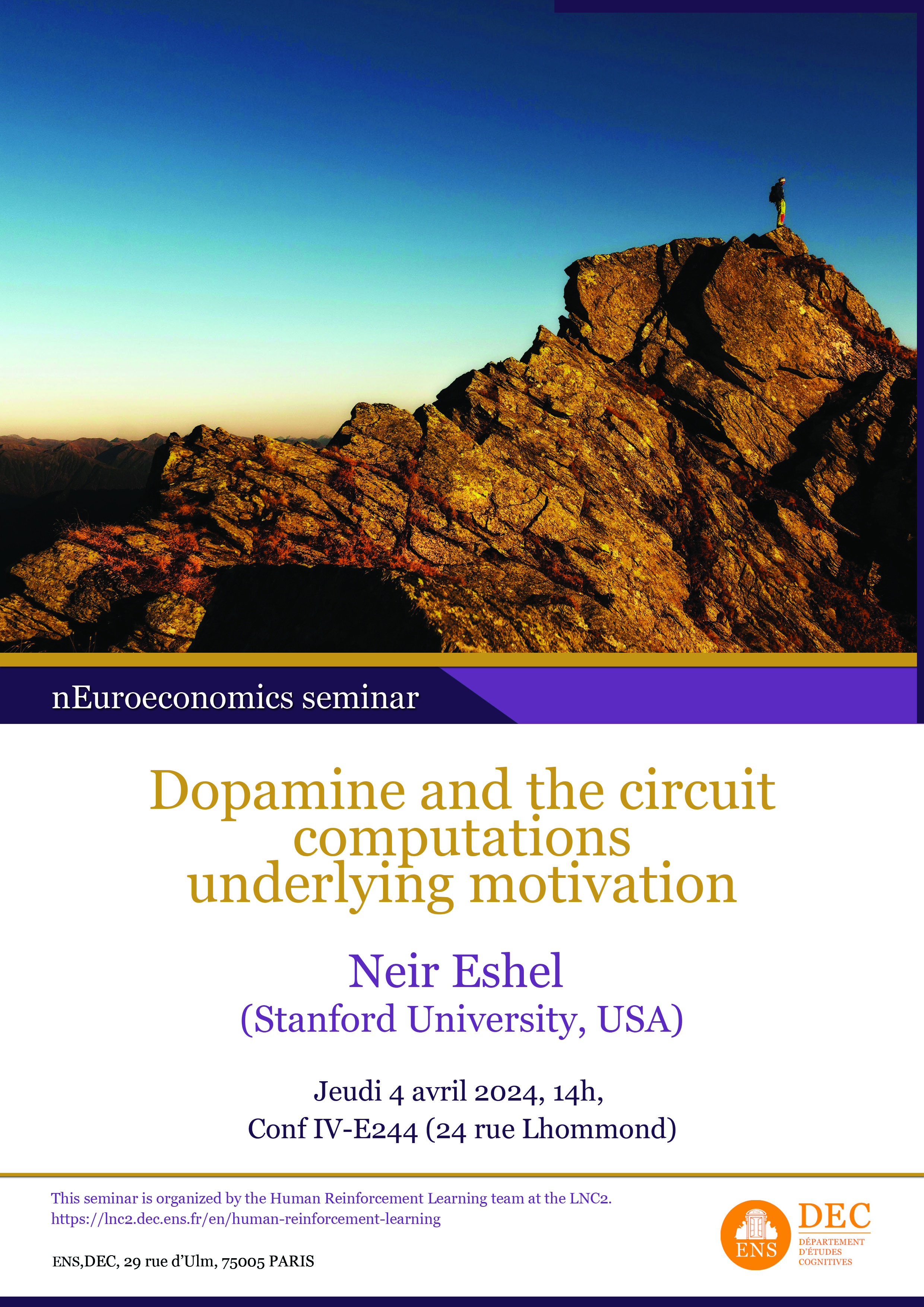
Dopamine and the circuit computations underlying motivation
ENS, salle Conf IV-E244, 24 rue Lhommond, 75005 Paris
 Motivation–the energizing of behavior in pursuit of a goal–is central to daily life. Disruptions in motivation underpin multiple neuropsychiatric disorders, from abnormally low motivation in anhedonia to abnormally high motivation in addiction. Although dopamine (DA) release has long been implicated in motivated behavior, the mechanisms of that link remain unclear. Even the direction of this effect is under debate, with evidence for both DA increases and decreases in settings of low and high motivation. In part, these conflicting results are due to a key gap in the field: most studies of motivation do not record DA release, and most studies of DA release do not measure motivation. Bridging this gap will be necessary to predict, track, and ultimately reverse DA-mediated motivational deficits. Recently we developed a task that applies principles of behavioral economics to provide a more precise measure of motivation than the commonly-used progressive-ratio task, unconfounded by reward dose or choice of ratios. When we paired this task with DA recordings in mice, we found that striatal DA release mapped strongly onto motivational level. Surprisingly, however, the relationship was inverse: in settings of high motivation, phasic DA release was suppressed. Furthermore, this inverse relationship between motivation and phasic DA release held true not only for natural food rewards but also for the artificial ‘reward’ of optogenetic stimulation of DA axons. In other words, the identical optogenetic stimulation evoked substantially different DA release, depending on the animal’s motivational state. We are now working to understand the mechanisms that regulate DA release even when the axons are directly depolarized, and probe how these varying levels of DA release modulate downstream circuits to control motivated behavior. Our preliminary findings implicate a key role for nicotinic cholinergic receptors on DA axons, as well as D2 DA receptors on striatal neurons. Together, our approach—combining optogenetic stimulation with fiber photometry recording during a task that directly measures motivational state—has the potential to unravel core mysteries in the link between DA and motivation.
Motivation–the energizing of behavior in pursuit of a goal–is central to daily life. Disruptions in motivation underpin multiple neuropsychiatric disorders, from abnormally low motivation in anhedonia to abnormally high motivation in addiction. Although dopamine (DA) release has long been implicated in motivated behavior, the mechanisms of that link remain unclear. Even the direction of this effect is under debate, with evidence for both DA increases and decreases in settings of low and high motivation. In part, these conflicting results are due to a key gap in the field: most studies of motivation do not record DA release, and most studies of DA release do not measure motivation. Bridging this gap will be necessary to predict, track, and ultimately reverse DA-mediated motivational deficits. Recently we developed a task that applies principles of behavioral economics to provide a more precise measure of motivation than the commonly-used progressive-ratio task, unconfounded by reward dose or choice of ratios. When we paired this task with DA recordings in mice, we found that striatal DA release mapped strongly onto motivational level. Surprisingly, however, the relationship was inverse: in settings of high motivation, phasic DA release was suppressed. Furthermore, this inverse relationship between motivation and phasic DA release held true not only for natural food rewards but also for the artificial ‘reward’ of optogenetic stimulation of DA axons. In other words, the identical optogenetic stimulation evoked substantially different DA release, depending on the animal’s motivational state. We are now working to understand the mechanisms that regulate DA release even when the axons are directly depolarized, and probe how these varying levels of DA release modulate downstream circuits to control motivated behavior. Our preliminary findings implicate a key role for nicotinic cholinergic receptors on DA axons, as well as D2 DA receptors on striatal neurons. Together, our approach—combining optogenetic stimulation with fiber photometry recording during a task that directly measures motivational state—has the potential to unravel core mysteries in the link between DA and motivation.
More info about the nEuro-economics seminar series
